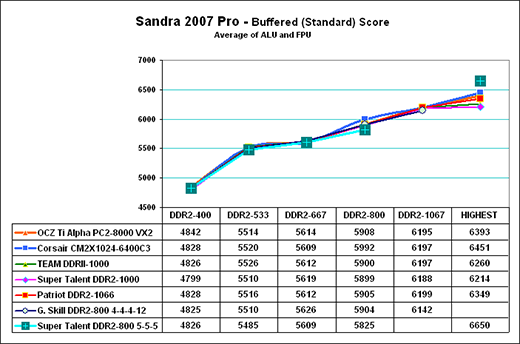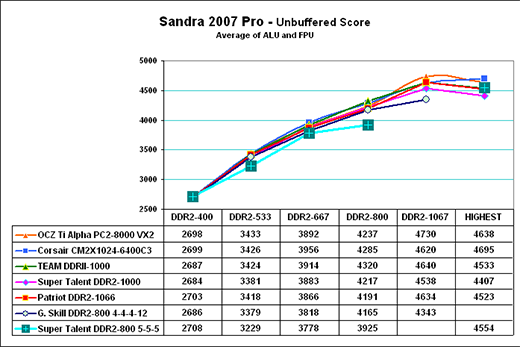Value DDR2-800 from Super Talent: Where Can You Go?
by Wesley Fink on November 29, 2006 12:05 AM EST- Posted in
- Memory
Memory Bandwidth Scaling
Memory bandwidth normally improves with increases in memory speed and reductions in memory timings. This is best illustrated using Performance Scaling charts instead of the bar charts for individual speeds that were used in past memory reviews.
Since the results for high-end memory were so close at all tested speeds, the scale range was reduced to better show the small differences in these memory benchmark results. Please keep this in mind when viewing the charts, since a normal zero scale would make performance differences appear much smaller than these expanded scale charts. Values for the tested memories are included below each chart for reference.
To evaluate memory bandwidth SiSoft Sandra 2007 Professional is used to provide a closer look at scaling for fast DDR2 memory.

The most widely reported Sandra score is the Standard or Buffered memory score. This benchmark takes into account the buffering schemes like MMX, SSE, SSE2, SSE3, and other buffering tools that are used to improve memory performance. Buffered bandwidth performance of the Super Talent memory was virtually the same as the previously tested high-end DDR2 memory at DDR2-800. The Super Talent could not reach DDR2-1067 with stability and topped out at DDR2-1000. Performance at DDR2-1000 cannot be directly compared to other top-end results since the system is modestly overclocked using a DDR2-889 ratio at a FSB setting of 300 where the other memories used a DDR2-1067 ratio.
The Buffered benchmark does not correlate well with real performance differences in games, so our memory bandwidth tests have always included an Unbuffered Sandra memory score. The Unbuffered result turns off the buffering schemes, and we have found the difference in Unbuffered results correlate well with real-world performance differences.

In Unbuffered tests the Super Talent mirrors the best memory tested to DDR2-800, but at a slightly lower performance due to the slower timings. There is no DDR2-1067 performance with the Super Talent and the highest stable speed, DDR2-1000, required a DDR2-889 memory ratio at a bus overclock to 300. It is worth pointing out, however, that memory bandwidth, both buffered and Unbuffered, continue to increase with memory speed.
We also compared results with Version 1.5 of Super Pi - comparing the time to calculate 2 million places of Pi at the different memory speeds. This benchmark measures pure number crunching.

Super Pi results continue to improve all the way to the highest speed that could be reached with stability with each memory. The second result that stands out is how very close the results with all the memories really are.. All four top-end memories perform very similarly. . The Super Talent drops off a bit at the top and bottom due to slightly slower timings in those ranges. The mid-range G. Skill performs similarly until DDR2-1067 where slower timings finally provide a penalty. The Super Talent DDR2-800 value memory drops off a bit at DDR2-800 due to slightly slower timings, but the performance is still remarkably close to the best we have tested. While performance is very close, Super Pi scaling charts continue to show the useful sensitivity of Super Pi as a measurement of memory performance
Memory bandwidth normally improves with increases in memory speed and reductions in memory timings. This is best illustrated using Performance Scaling charts instead of the bar charts for individual speeds that were used in past memory reviews.
Since the results for high-end memory were so close at all tested speeds, the scale range was reduced to better show the small differences in these memory benchmark results. Please keep this in mind when viewing the charts, since a normal zero scale would make performance differences appear much smaller than these expanded scale charts. Values for the tested memories are included below each chart for reference.
To evaluate memory bandwidth SiSoft Sandra 2007 Professional is used to provide a closer look at scaling for fast DDR2 memory.

The most widely reported Sandra score is the Standard or Buffered memory score. This benchmark takes into account the buffering schemes like MMX, SSE, SSE2, SSE3, and other buffering tools that are used to improve memory performance. Buffered bandwidth performance of the Super Talent memory was virtually the same as the previously tested high-end DDR2 memory at DDR2-800. The Super Talent could not reach DDR2-1067 with stability and topped out at DDR2-1000. Performance at DDR2-1000 cannot be directly compared to other top-end results since the system is modestly overclocked using a DDR2-889 ratio at a FSB setting of 300 where the other memories used a DDR2-1067 ratio.
The Buffered benchmark does not correlate well with real performance differences in games, so our memory bandwidth tests have always included an Unbuffered Sandra memory score. The Unbuffered result turns off the buffering schemes, and we have found the difference in Unbuffered results correlate well with real-world performance differences.

In Unbuffered tests the Super Talent mirrors the best memory tested to DDR2-800, but at a slightly lower performance due to the slower timings. There is no DDR2-1067 performance with the Super Talent and the highest stable speed, DDR2-1000, required a DDR2-889 memory ratio at a bus overclock to 300. It is worth pointing out, however, that memory bandwidth, both buffered and Unbuffered, continue to increase with memory speed.
We also compared results with Version 1.5 of Super Pi - comparing the time to calculate 2 million places of Pi at the different memory speeds. This benchmark measures pure number crunching.

Super Pi results continue to improve all the way to the highest speed that could be reached with stability with each memory. The second result that stands out is how very close the results with all the memories really are.. All four top-end memories perform very similarly. . The Super Talent drops off a bit at the top and bottom due to slightly slower timings in those ranges. The mid-range G. Skill performs similarly until DDR2-1067 where slower timings finally provide a penalty. The Super Talent DDR2-800 value memory drops off a bit at DDR2-800 due to slightly slower timings, but the performance is still remarkably close to the best we have tested. While performance is very close, Super Pi scaling charts continue to show the useful sensitivity of Super Pi as a measurement of memory performance










28 Comments
View All Comments
slayerized - Wednesday, November 29, 2006 - link
The last week has seen a sudden drop in memory prices. There are quite a few DDR2 800 modules in the 200 price (-1/+30-40) range on newegg with better timings.G.Skill F2-6400CL4D-2GBPK is one of the products out there ($204) with rated timings of 4-4-4-12. I realize anandtech posted another g.skill ddr2 800 review a few days back, but i am pretty sure this is different. I think things are looking better in the memory side of things and prices should stabilize in the affordable range even for enthusiast memories soon (hopefully). Right now the trend is ridiculous.
Turin39789 - Thursday, November 30, 2006 - link
It would have been nice for them to look at several memories, I'm not even sure why they tested this module except the manufacturer is launching the product and needs press. When you are looking for valueram and there are products that are more than 15% cheaper, that's what the budget minded are looking at. I want to know how the $200 sticks work and I want to see them compared with each other, similar to the treatment the high end stuff gets.Turin39789 - Thursday, November 30, 2006 - link
It would have been nice for them to look at several memories, I'm not even sure why they tested this module except the manufacturer is launching the product and needs press. When you are looking for valueram and there are products that are more than 15% cheaper, that's what the budget minded are looking at. I want to know how the $200 sticks work and I want to see them compared with each other, similar to the treatment the high end stuff gets.Spacecomber - Wednesday, November 29, 2006 - link
Are those the proper results with a mis-labeled heading, or did the wrong results find their way into the article? The results are titled G.Skill F2-6400PHU2-2GBHZ.Wesley Fink - Wednesday, November 29, 2006 - link
Web Editing used an older template, updated the results, but not the title. The results were for the Super Talent DDR2-800. The table is now corrected.Wesley Fink - Wednesday, November 29, 2006 - link
Web Editing used an older template, updated the results, but not the title. The results were for the Super Talent DDR2-800. The table is now corrected.lopri - Wednesday, November 29, 2006 - link
Probably mis-labeled. I'm seeing G-skill, too.ashegam - Wednesday, November 29, 2006 - link
is it me, or do these memory modules look like Walmart branded memory, at first glance? :)n7 - Wednesday, November 29, 2006 - link
There's almost no way this is D9GMH/D9GKX.This is likely very good Promos or possibly Elpida.
Definitely not too bad results considering it's using a crap IC.
OrSin - Wednesday, November 29, 2006 - link
"Since when is pretty good? The article is ok, but this line made me laugh. Reminds me of dells new pretty cases and the crap inside. Not all dells are crap but please dont buy a gaming rig from them and expect a true gaming computer.